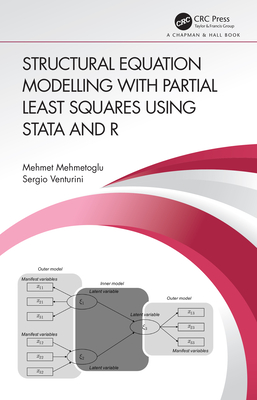買這商品的人也買了...
-
 $2,928The R Book, 2/e (Hardcover)
$2,928The R Book, 2/e (Hardcover) -
 $2,240An Introduction to Statistical Learning: With Applications in R (Hardcover)
$2,240An Introduction to Statistical Learning: With Applications in R (Hardcover) -
 Introduction to Probability Simulation and Gibbs Sampling with R (Paperback)
Introduction to Probability Simulation and Gibbs Sampling with R (Paperback)$4,190$3,981 -
 $1,744Time Series Analysis: Forecasting and Control, 5/e (Hardcover)
$1,744Time Series Analysis: Forecasting and Control, 5/e (Hardcover) -
 Probabilistic Machine Learning: An Introduction (Hardcover)
Probabilistic Machine Learning: An Introduction (Hardcover)$2,650$2,597 -
 Deep Generative Modeling
Deep Generative Modeling$3,160$3,002
商品描述
This step-by-step guide is written for R and latent variable model (LVM) novices. Utilizing a path model approach and focusing on the lavaan package, this book is designed to help readers quickly understand LVMs and their analysis in R. The author reviews the reasoning behind the syntax selected and provides examples that demonstrate how to analyze data for a variety of LVMs. Featuring examples applicable to psychology, education, business, and other social and health sciences, minimal text is devoted to theoretical underpinnings. The material is presented without the use of matrix algebra. As a whole the book prepares readers to write about and interpret LVM results they obtain in R.
Each chapter features background information, boldfaced key terms defined in the glossary, detailed interpretations of R output, descriptions of how to write the analysis of results for publication, a summary, R based practice exercises (with solutions included in the back of the book), and references and related readings. Margin notes help readers better understand LVMs and write their own R syntax. Examples using data from published work across a variety of disciplines demonstrate how to use R syntax for analyzing and interpreting results. R functions, syntax, and the corresponding results appear in gray boxes to help readers quickly locate this material. A unique index helps readers quickly locate R functions, packages, and datasets. The book and accompanying website at http://blogs.baylor.edu/rlatentvariable/ provides all of the data for the book’s examples and exercises as well as R syntax so readers can replicate the analyses. The book reviews how to enter the data into R, specify the LVMs, and obtain and interpret the estimated parameter values.
The book opens with the fundamentals of using R including how to download the program, use functions, and enter and manipulate data. Chapters 2 and 3 introduce and then extend path models to include latent variables. Chapter 4 shows readers how to analyze a latent variable model with data from more than one group, while Chapter 5 shows how to analyze a latent variable model with data from more than one time period. Chapter 6 demonstrates the analysis of dichotomous variables, while Chapter 7 demonstrates how to analyze LVMs with missing data. Chapter 8 focuses on sample size determination using Monte Carlo methods, which can be used with a wide range of statistical models and account for missing data. The final chapter examines hierarchical LVMs, demonstrating both higher-order and bi-factor approaches. The book concludes with three Appendices: a review of common measures of model fit including their formulae and interpretation; syntax for other R latent variable models packages; and solutions for each chapter’s exercises.
Intended as a supplementary text for graduate and/or advanced undergraduate courses on latent variable modeling, factor analysis, structural equation modeling, item response theory, measurement, or multivariate statistics taught in psychology, education, human development, business, economics, and social and health sciences, this book also appeals to researchers in these fields. Prerequisites include familiarity with basic statistical concepts, but knowledge of R is not assumed.
商品描述(中文翻譯)
這本逐步指南是為 R 和潛變量模型 (LVM) 新手所撰寫。利用路徑模型方法,並專注於 lavaan 套件,本書旨在幫助讀者快速理解 LVM 及其在 R 中的分析。作者回顧所選語法背後的推理,並提供示例,展示如何分析各種 LVM 的數據。本書包含適用於心理學、教育、商業及其他社會和健康科學的示例,對理論基礎的文字描述極少。材料的呈現不使用矩陣代數。整體而言,本書使讀者能夠撰寫和解釋他們在 R 中獲得的 LVM 結果。
每章都包含背景資訊、在詞彙表中定義的粗體關鍵術語、R 輸出的詳細解釋、如何撰寫結果分析以供發表的描述、摘要、基於 R 的實踐練習(解答包含在書的後面)以及參考文獻和相關閱讀。邊欄註解幫助讀者更好地理解 LVM 並撰寫自己的 R 語法。使用來自各種學科已發表工作的數據的示例展示了如何使用 R 語法來分析和解釋結果。R 函數、語法及相應的結果以灰色框顯示,以幫助讀者快速找到這些材料。一個獨特的索引幫助讀者快速定位 R 函數、套件和數據集。這本書及其附屬網站 http://blogs.baylor.edu/rlatentvariable/ 提供了書中示例和練習所需的所有數據,以及 R 語法,以便讀者能夠重現分析。書中回顧了如何將數據輸入 R、指定 LVM 以及獲取和解釋估計的參數值。
本書開篇介紹了使用 R 的基本知識,包括如何下載程式、使用函數以及輸入和操作數據。第二章和第三章介紹並擴展路徑模型以包含潛變量。第四章展示了如何使用來自多個組的數據分析潛變量模型,而第五章則展示了如何使用來自多個時間段的數據分析潛變量模型。第六章演示了二元變量的分析,第七章則展示了如何分析缺失數據的 LVM。第八章專注於使用蒙地卡羅方法確定樣本大小,這可以用於各種統計模型並考慮缺失數據。最後一章探討了分層 LVM,展示了高階和雙因子方法。本書以三個附錄結束:回顧模型擬合的常見指標,包括其公式和解釋;其他 R 潛變量模型套件的語法;以及每章練習的解答。
本書旨在作為研究生和/或高年級本科生的補充教材,適用於心理學、教育、人類發展、商業、經濟學及社會和健康科學中教授的潛變量建模、因素分析、結構方程模型、項目反應理論、測量或多變量統計課程,對這些領域的研究人員也具有吸引力。先決條件包括對基本統計概念的熟悉,但不假設具備 R 的知識。










